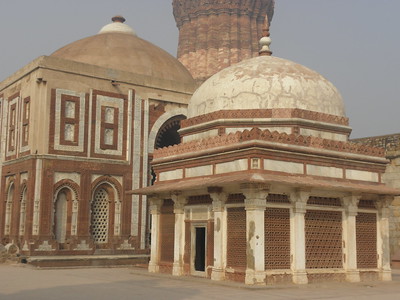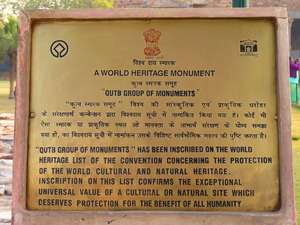Qutb Minar

Qutb Minar and its Monuments, Delhi comprises a group of religious and funerary buildings that display the architectural and artistic achievements of early Islamic India.
The 13th-century complex includes the Quwwatu'l-Islam mosque, the earliest extant mosque in northern India, and the 72m high minaret Qutb Minar. The site also holds the Iron Pillar, built during the Gupta Empire in the 4th century CE - a standing testimony to the metallurgical skill of ancient Indians.
Community Perspective: a serene, smallish site to visit in Delhi. Besides the main structures, the Tomb of Iltutmish is also recommended for its fine carvings.

Map of Qutb Minar
Community Reviews
Carlo Sarion
Philippines/New Zealand - 13-May-24 -

This complex of mosques, tombs, towers, and other structures was the first site we visited on my “revenge” trip to India in Dec 2023, having missed this back in Dec 2013. The site is located in the Mehrauli neighbourhood in southern Delhi and is adjacent to the Mehrauli Archaeological Park. This site is a pretty solid testament to early Islamic art in India and it deserves to be a part of everyone’s itinerary in Delhi.
We went mid-morning, hoping that the smog would be gone by that time. The ticket booth, shops, food stalls, and toilets are located across the site’s main entrance. We paid INR 500 for the entrance ticket (as foreign travellers) and went straight in to avoid the influx of visitors, which were mostly students. We visited all the main structures within the complex.
1. Qutb Minar
Qutb Minar is located at the southern end of the complex. As its name suggests, this "victory tower" seemed to have served more as a showpiece than an actual minaret where the muezzin called for prayers. It is an imposing structure made up of several stories of sandstone. Taking a closer look at the column you would see combinations of intricate Islamic geometric designs and Indian floral patterns that were reflective of the artistry at the time. It's great to see how rulers and governments have preserved this tower, given that Delhi also experiences a fair share of seismic activity. I'd call this tower the luckier twin of the Minaret of Jam, which was constructed around the same time.
On the opposite side of Qutb Minar and past the Quwwatu'l-Islam mosque is Alai Minar. Only a single storey was constructed, and it would've been much more massive than Qutb Minar had it been completed.
2. Quwwatu’l-Islam Mosque
The mosque that Qutb Minar serves as a minaret for, Quwwatu’l-Islam Mosque is considered the first mosque built in Delhi after the Islamic conquest of the city. The mosque must have been pretty impressive during its heyday. The cloister columns of the mosque were built using stones from demolished Hindu and Jain temples that previously stood on the site. You'd understand right away the Hindu and Jain origin of the stones because of the carvings. What a way to announce the establishment of the power of the new rulers of Delhi, though I also thought this was a smart, efficient, and economic use of available resources. This website says that the local craftsmen who built the mosque plastered the columns to cover the carvings, but the plaster has fallen away over centuries.
The iron pillar at the centre of the mosque is another highlight. It is beautifully framed by the pointed arches of the remaining part of the mosque's wall behind it. The pillar is thought to predate the mosque and the complex itself, and architects, metallurgists, and archaeologists wonder why it has evaded rusting since 1,500 years ago.
3. Tombs and other structures
In addition to Qutb Minar and the mosque, the tombs of Imam Zamin, Alauddin Khalji, and Iltutmish are also found in the complex. The tomb of Iltutmish is noteworthy, particularly because of the detailed carvings of the mihrab on the inner wall of the building. The building that housed Alauddin Khalji's tomb also served as a learning centre (madrasa). Alai Darwaza is another structure found inside the complex and stands beside Qutb Minar. It was said to be the gateway of Quwwatu’l-Islam mosque, and the entrance arch is beautiful and gives off a serene atmosphere when viewed from the inside. Note the elaborate carvings on the inner walls of Alai Darwaza. The top portions of Alai Darwaza and the tomb of Imam Zamin are in the foreground of the photo above, in front of Qutb Minar.
We stayed on the site for about one and a half hours. It was getting warmer so we decided to go back to the car and head for lunch. While hiring a guide is a convenient option, I don't think it is necessary given that the site is small, manageable, and quite peaceful. You just need a good map to explore this site.
Clyde

I visited this WHS in January 2012. The 72.5m red sandstone and marble Minaret alone, already deserves being inscribed in the list. The intricate carvings with arabic calligraphy and islamic symbols are truly incredible and can be seen from every angle adorning the tallest minaret in India. The rest of the site is made up of interesting remains, tombs and an early mosque.
Els Slots

This was the first stop on my full-day tour of Delhi sights. The complex has a serene atmosphere, enhanced a little by the famous Delhi morning fog. You can sit on park benches and take in the views of these old constructions. There were about 20 other western visitors around, more than I had seen at any site outside of Delhi.
The focal point of the complex obviously is the enormous minaret. You only really feel how broad and tall it is when you're standing next to it. A magnificent piece of work.
And then there's the enigmatic Iron Pillar. It looks so out of place here, in this whole complex full of brick and sandstone buildings. It's a very thin pillar, surrounded by a fence to protect it. It looks as if it was placed here only recently, at the start of modern construction.
Another monument that I enjoyed here was the Tomb of Iltutmish. It's a bulky structure when looked at from the outside and it is missing its roof. The interior however has lots of fine carvings, both in red sandstone and white marble.
Jacob Choi
United States of America - 01-May-05 -
Qutb Minar and it's monument's in Delhi is amazing although there has been some canges over the years for example you can't try to put your hands on the Iron Pillar beacause theres a gate around it. But the rewrds are amazing it's basiclly a complex so expect 1hour-1 and a half hour to explore the whole thing. The admission price for this monument is as falows,250 Rupees for all adults, children are free.
Christer Sundberg

Having muscled through the traffic of central Dehli to the southern suburbs, I found myself at the Qtub Minar, the 73 meter high minaret and one of the true landmarks of the city. Whether it was really meant as a minaret or just a watch tower seem to be still under discussion but it was unquestionably built in the late 12th century by Qutub-ud-din Aibak.
Standing next to the Quwwat-ul-Islam mosque and many other temples in a nice park, it's a peaceful excursion that could last you an hour or two. And while you are there, don't miss Ala-ud-Din's unfinished minaret, meant to be twice as high as the Qtub Minar, but left at 27 meters at the time of his death.
Rob Wilson
The Qutb Minar complex is an incredible self-proclamation of Islams arrival in India. When you consider the age of the Minar itself it makes it all the more impressive.
The unrusted ancient iron pole at the site is a wonderful unsolved mystery. How can iron be so pure that it doesn't rust?
Community Rating
- : Roman Raab Thomas Kunz Frediehung BH Bag-packer-family Travelure Shombob Mihai Dascalu Amitlchoudhuryjbp Fede1203 Laurine
- : Wojciech Fedoruk Daniel Gabi Ralf Regele Giulio25
- : Gary Arndt Tony H. Philipp Peterer Craig Harder Bernard Joseph Esposo Guerrero Chalamphol Therakul Randi Thomsen Svein Elias Vernon Prieto Stanislaw Warwas Chenboada Zoë Sheng CalvinLoh Hurrvinek HaraldOest Dorejd Aspasia Mauralin13 Rvieira Akacesfan Rich Forrest Roxfts Campmany Lembu
- : Els Slots Mikko Martina Rúčková YAO WEI David Marton Luke LOU Shandos Cleaver Ludvan Richard Stone Tarquinio_Superbo Juropa Alikander99 GerhardM
- : Joyce van Soest Frederik Dawson Alexander Parsons Riccardo Quaranta Jean Lecaillon Alexander Lehmann Kevin McFarland Carlo Sarion Alex Marcean Lichia Mahuhe Philipp Leu Priyaranjan Mohapatra Subhayan_svnit Adiaro18 Jon Opol Javier
- : Solivagant Clyde Nan Lucio Gorla Travtasy Akhilpreeti
- : Adrian Turtschi Gordon Mitchell
- : Sachin
Site Info
Site History
1993 Inscribed
Site Links
Unesco Website
Official Website
In the News
Connections
The site has 27 connections
Art and Architecture
Constructions
Geography
History
Individual People
Religion and Belief
Timeline
Trivia
Visiting conditions
WHS Hotspots
WHS Names
WHS on Other Lists
World Heritage Process
Visitors
356 Community Members have visited.
The Plaque
 (photo by Clyde)
(photo by Clyde)